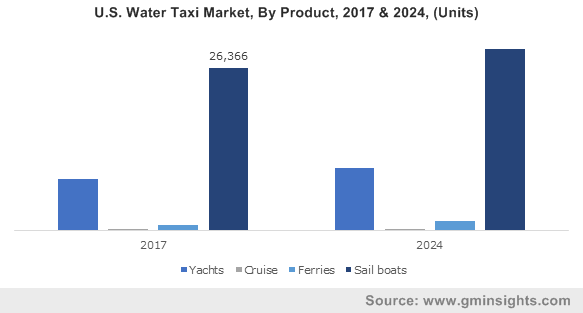North America to dominate water taxi market over 2018-2024, growing environmental concerns and the expanding tourism sector to propel the industry growth
Publisher : Fractovia | Published Date : 2018-04-26Request Sample
The rise in the interest for adopting ecofriendly means of transportation has been a pivotal driving force for water taxi market. Water taxis have played a major role in promoting tourism and are specifically used as vital means of transportation in cities like Venice and Amsterdam, where waterways form a significant section of the transit system. Indeed, this has been the reality for most of the harbor towns that gained commercial popularity and success due to their access to shipping during the 19th century.
U.S. Water Taxi Market, By Product, 2017 & 2024, (Units)

Currently, the revival of water-based transit has been occurring at a robust pace, as cities across the globe are burdened with traffic congestions, rising pollution and the detrimental impact of carbon emissions from fuel-based vehicles. Therefore, it does not come as a surprise that services like the inter-borough ferry in New York are being applauded by the public and facilitated by authorities. The passenger and bicycle carrying vessels are planned to operate in all the boroughs in New York and will have 22 landing in 6 different routes. The waterborne transit system which costs around $325 million is estimated to carry more than 50 million passengers on an annual basis, paving the way for the progress of the regional water taxi industry.
Close to half a decade earlier, a study had been conducted by several counties along the Potomac River in Maryland, U.S.. The findings revealed that the area’s notable population and the employment of a significant number of people in places located along the river will be able to encourage people’s foray from cars onto boats, which would massively propel the regional water taxi market share. Despite the fact that these water taxis are fueled by diesel, it is vital to remember that they are still considerably less detrimental to the environment than diesel cars. This is because they can carry several commuters in a single trip unlike cars, most of which are used on a private basis. Indeed, diesel taxis are expected to hold around 58% of the overall water taxi industry share over 2018-2024, driven by their long-standing deployment in the marine sector.
The rising penetration of the green movement has lately spurred manufacturers to shift their focus toward building more hybrid boats. As such, these boats cause a substantial improvement in the levels of noise and water pollution as compared to diesel water taxis and are expected to be widely in demand in the future. On these grounds, hybrid-based water taxi market is anticipated to register a 5% CAGR over 2018-2024.
North America has been touted to emerge as one of the most remunerative grounds for water taxi market, primarily owing to the presence of a robust marine industry and leading companies that have their base in the region. With enthusiastic players striving to make marine transportation attractive to a wider commuter pool and the increasing inclination toward luxury outdoor recreation activities, the continent is expected to register substantial growth in the ensuing years. Indeed, as per estimates, North America will emerge as the dominant region in the overall water taxi market with a projected size of $287 billion by 2024.
Along with North America, Asia Pacific will also register a significant growth in the water taxi market with cities like Hong Kong set to revive its water taxi facility to boost the tourism industry. The Commerce and Economic Development Bureau of Hong Kong passed the proposal of bringing water taxis to the city that will not only offer tourists a better experience of the island city but also put Hong Kong on the map alongside cities like Venice, Bangkok and Sydney that already have an established water taxi service. Additionally, the authorities are planning to introduce significant technological inputs and operate the water taxis in the same way as Uber, that is, passengers can hail their water rides with the use of their smartphones.
Water taxis have been paving their way across Europe, especially in cities such as Paris where hydrofoil taxis have become an added attraction for tourists. Called Seabubbles, these taxis are being designed to run on electric power on the river Seine. Reportedly, if the Seabubbles are a success in Paris then a similar types of hydrofoil taxis may commence operations on the Thames in London. The use of hydrofoil technology will mean that the boats will be lifted off the surface of water, decreasing the drag factor and resulting in a smoother ride. Other technological additions such as sensors for detecting obstacles on the water and an auto-mooring system are also being planned to be added to the Seabubbles, making them truly futuristic water taxis. It is thus rather overt that the expansive tourism industry will add lucrative growth prospects to water taxi market.
Increasing concerns for the environment and the subsequent interest to find less congested transport routes will be the pivotal driving forces for water taxi market over 2017-2024. Powered by a slew of initiatives undertaken by authoritative bodies to bring forth some effective changes in the transportation system and reign in the cumulative problems green house gases in the air are causing, water taxi industry size is expected to be valued over $500 billion by 2024.